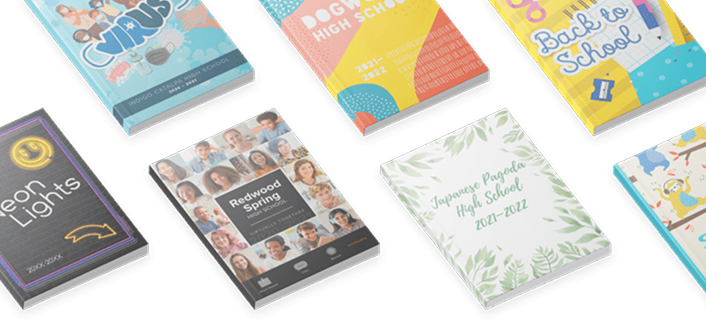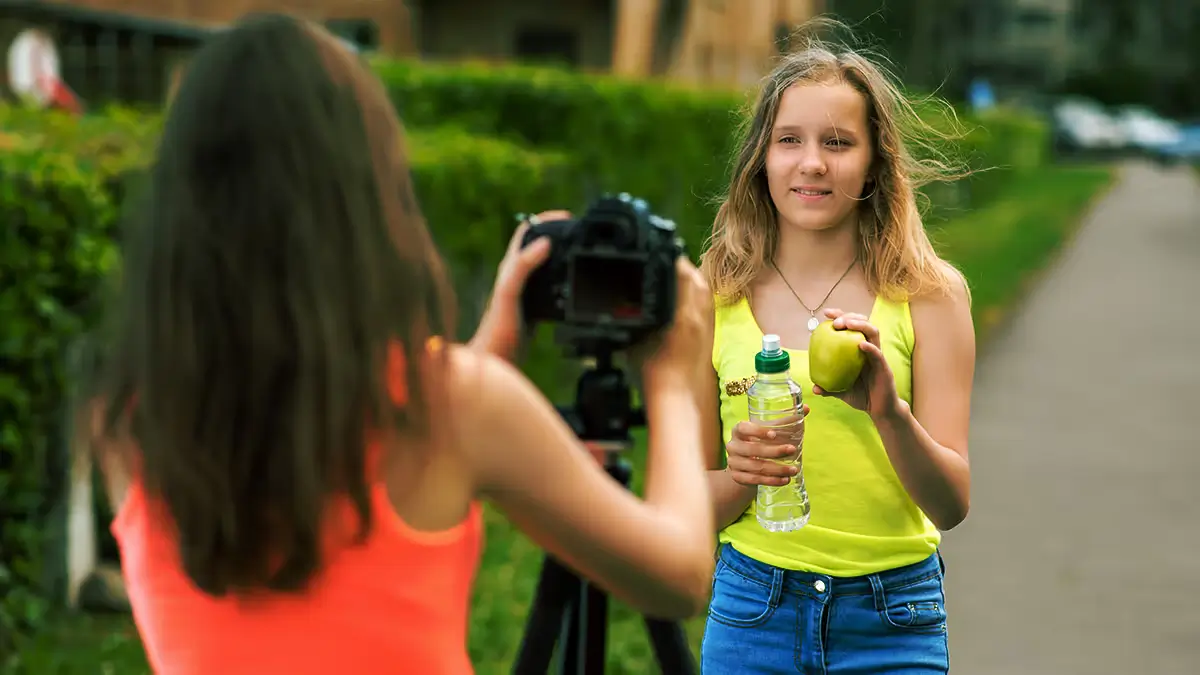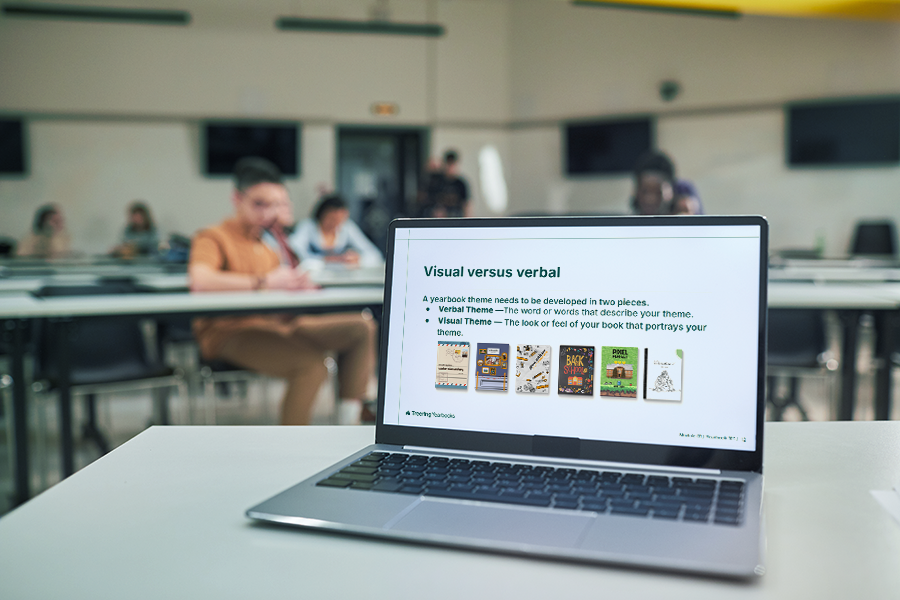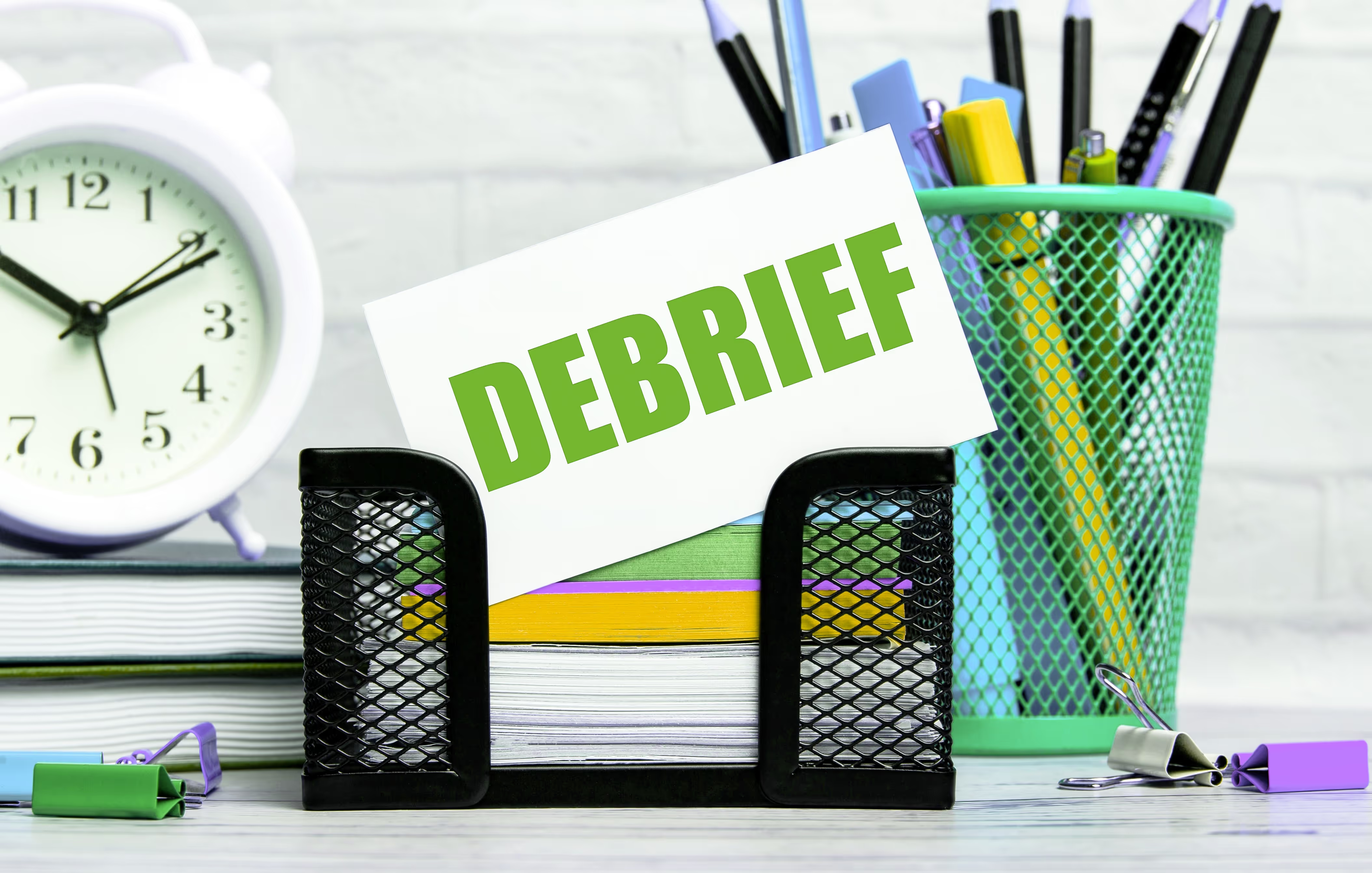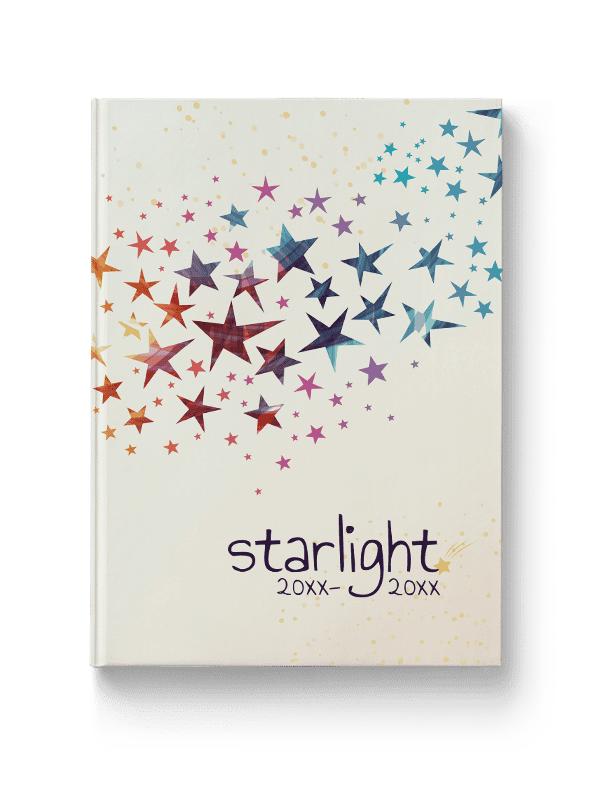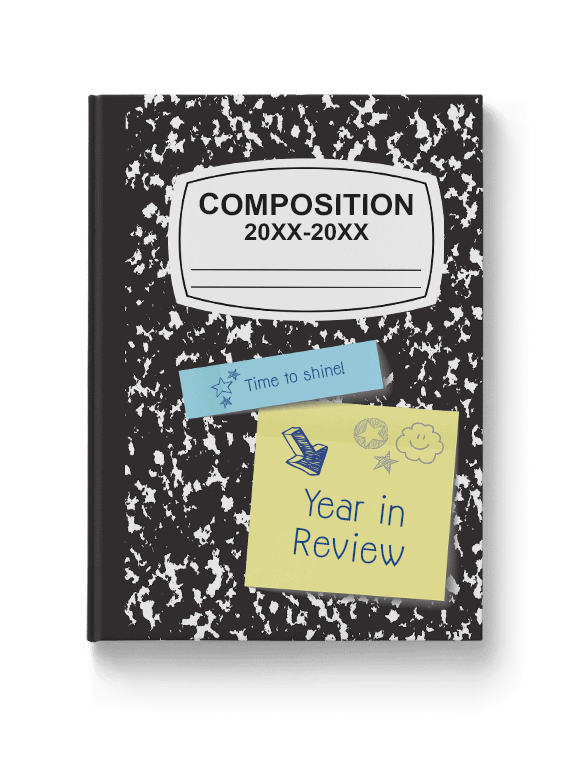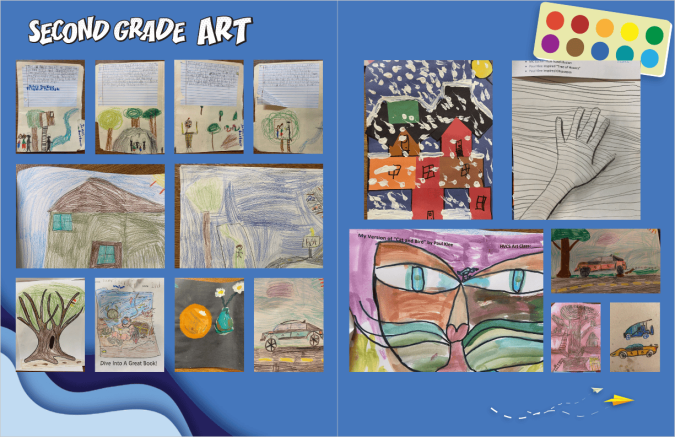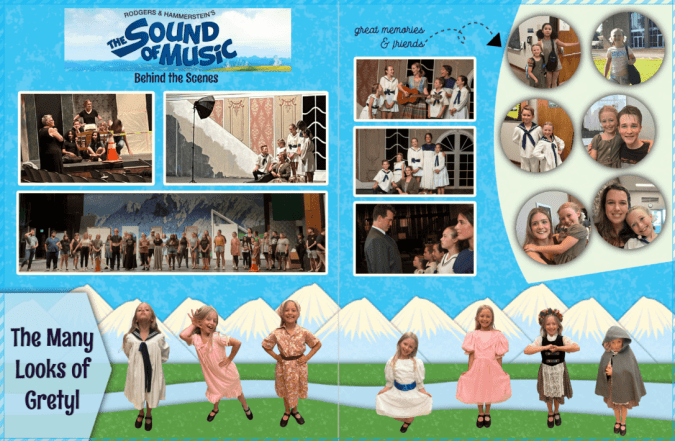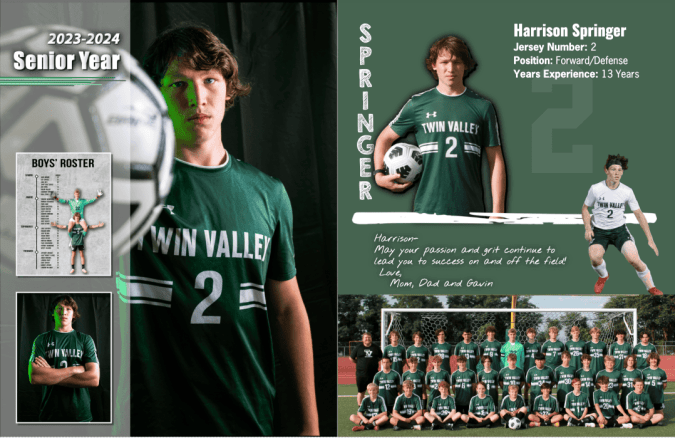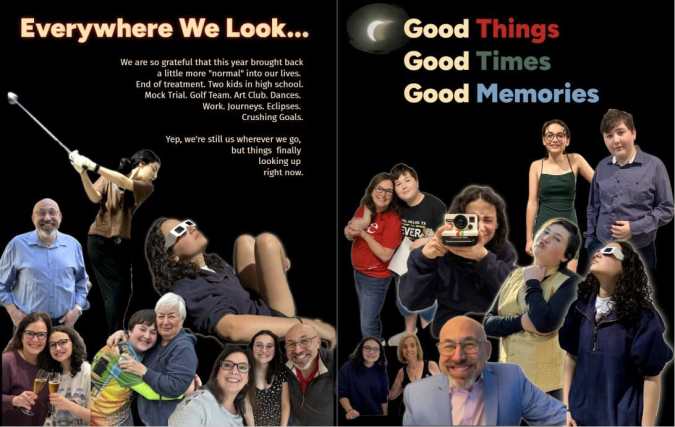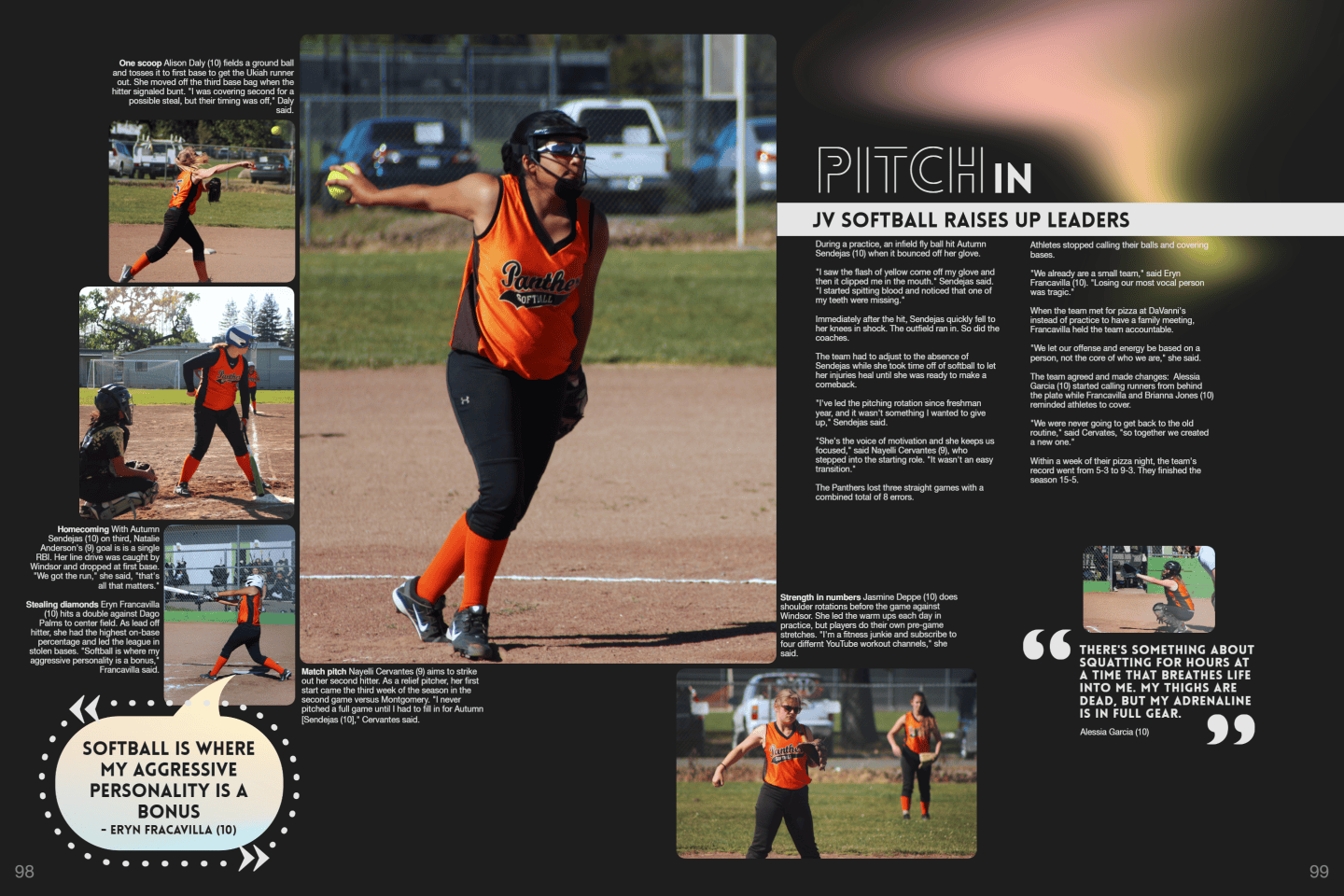Most popular
Subscribe to our blog
Most recent

How to write a yearbook story people will love to read
A good yearbook staff needs to know how to write a yearbook story, but that can be easier said than done. After all, writing something that people enjoy reading takes a lot of practice—even more than yearbook design and photography. And by the time you're done working with your students on all the other aspects of creating a yearbook, well, there's not a whole bunch of time left to spend practicing how to write a yearbook story.
That's why we wrote this post.
In it, you'll learn five easy-to-follow tips you and your yearbook staff can start using to improve all the copy in your yearbook, especially the copy that makes up your yearbook stories. We have pointers on improving headlines, writing ledes, finding your voice, and laying out your yearbook stories.
Before we get to those tips, though, we want to spend a minute on the big reason knowing how to write a yearbook story is important. And that's this: If you overlook your yearbook copy in favor of bold designs and strong photos, your yearbook is incomplete. That's because your written yearbook stories put memories in context. They tie your narrative together. They make readers want to spend more time on your pages. They make readers revisit your yearbook over time.
Let's get on with those tips, then, shall we?
5 tips for how to write a yearbook story
1. Power up your headline
A strong headline can make or break your yearbook story. Headlines draw readers in with a promise or a bold claim. They hold attention and create anticipation. The best yearbook story headlines are:
- Short – they quickly summarize the content to come
- Specific – they tell readers exactly what to expect
- Standalone – they make a statement on their own
- Special – they are unique, powerful and interesting
Headlines have the power to transform a mediocre story into something truly spectacular.
For example, instead of using a straightforward headline such as:
"The Blue Hawks’ Memorable Season,"
add excitement with a headline that pops:
"The Blue Hawks Swoop In For an End-of-Season Win!"
The second option ups the emotion while giving readers a reason to find out more about how the Blue Hawks overcame challenges during the season. You can even try to switch up the format of your story by using a “list headline”, such as:
"5 Times the Blue Hawks Surprised Fans This Season"
Or:
"10 Reasons We Love Cheering for Our Blue Hawks"
Your yearbook story’s headline not only sets reader expectations, but also sets the tone for your following narrative. Which leads us to…
2. Take a strong lede
Lede is a journalism term for the opening section of a news story. (Need a primer on yearbook terms? Check out this blog post and interactive quiz to keep fresh.) Reporters start their articles with the most critical information, enticing readers to continue and ensuring readers grasp the story’s main message. Think about this when you write your yearbook story’s introduction. The beginning of your story should:
- Deliver on the promise made in your headline
- Give readers the critical information they need
- Introduce action, conflict or emotion
- Prompt readers to continue to learn more
Need an example? Go back to the lede of this blog post. In it, we tell you exactly why yearbook story content is critical, and how this article will help you write better stories. (If you’re reading this right now, our lede worked!)
3. Be an active writer
To write active and entertaining yearbook stories, you need to use active and entertaining language. And this means writing in the active voice. For those who need a refresher, active voice is when the subject of a sentence is doing the action, while passive voice is when the subject of a sentence is being acted upon. An example of passive voice:
"The team was cheered on by hundreds of fans."
This sentence falls flat, because the fans are acting upon the subject (the team). It’s easy to switch to active voice, however:
"Hundreds of fans cheered on the team."
In this new sentence, the subject of the sentence (hundreds of fans) performs the action.
Another way to keep your writing active is to use strong verbs. Verbs are words used to describe an action – and they can be strong or weak. “To be” verbs such as “am, is, are, was, were” often weaken a sentence. Here’s an example of a weak verb at play:
"The debate team is responsible for researching their topics."
Here’s the same sentence, using a strong verb:
"The debate team investigates their topics."
Strong verbs convey more meaning than weak verbs, and help bring a yearbook story to life.
4. Give it some voice
Quotes and testimonials from students, parents, faculty and staff are great ways to bring both personality and personal meaning to your yearbook stories. Whenever possible, include statements from the individuals who were directly involved in the stories you’re recapping.
- Interview the swimming star on her big win.
- Ask a science student about his favorite experiment.
- Talk to a teacher about how her students changed over the year.
These individual moments will give your yearbook stories more context and emotion.
5. Design your yearbook copy
While you may think of copy and design as two separate entities, design plays an important role in your copy's readability. The right fonts, layout and sentence structure all work together to move a reader easily and comfortably through a yearbook story. Here are some ways to better design your content:
- Keep sentences and paragraphs short.
- Cut out unnecessary words.
- Add subheads to divide stories into sections.
- Break up text with call-out quotations or facts.
- Use bullet points to list short moments or stories.
- Keep fonts simple – select one font style for headlines and one for body copy.
Finally, in both content and general page design, be aware of white space. Don’t fill every blank spot with text or imagery; let your story breathe. Take time to write focused, meaningful and engaging yearbook stories. You'll end up with a stronger picture of your school year.
When it comes to creating a yearbook, knowing how to write a yearbook story is important stuff. Even if great writing takes a lot of practice, there are some easy-to-follow tips that will get you closer by the day. Follow them, and your yearbook is sure to succeed.
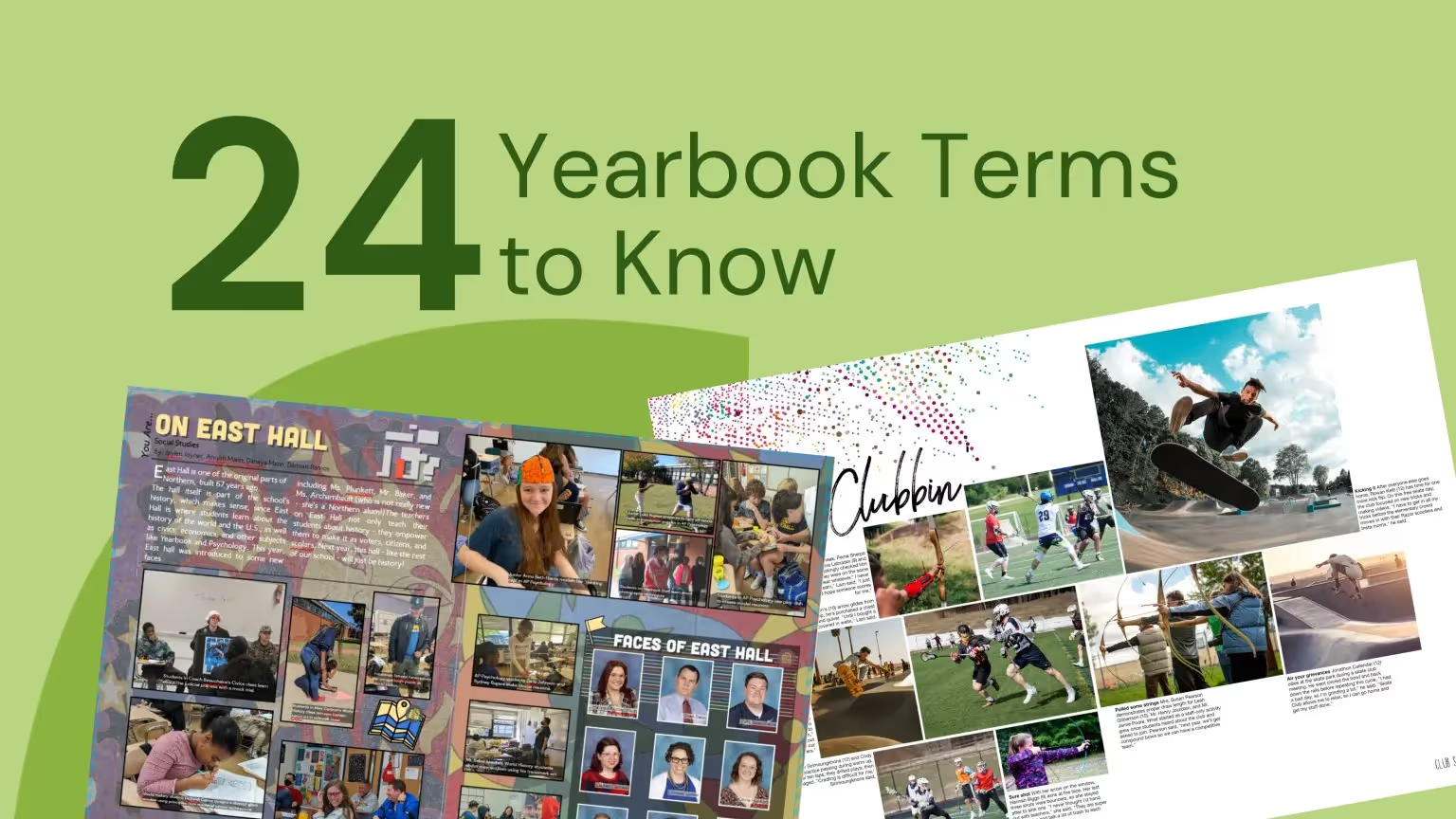
Teaching yearbook: 24 yearbook terms
Stuff. Thingamajig. Whatchamacallit.
If your day job isn’t in desktop publishing or graphic design (or teaching it), you and your yearbook team probably use those words to get across what you’re trying to say. You know what it is you’re trying to say, but you just … can’t … find … the yearbook terms you need to do it in a way that makes sense to everyone.
So, you use filler that causes more confusion than clarity.
We’ve talked to a bunch of yearbook advisers, and a lack of proper yearbook vocabulary is a common problem. Especially when new people join the team. We figured, then, that it would be good to pull together a list of yearbook terms everyone needs to know (and a whole bunch more that just about everyone should know).
Study up, and you could be skipping this type of painful conversation in nearly no time at all:
“We need to get that thing on page 8 done, so we can get those pages proofed?”
“What stuff?”
“You know… the… the… It’s right next to the whatchamacallit.”
“I’m not really sure what you’re talking about… You mean the thingamajig that I was working on?”
(Ouch.)
And, besides avoiding a conversation as bad and confusing as this, who doesn’t like learning new… uhh… stuff?
A list of yearbook terms everyone needs to know
- Bleed. The bleed is extra space around your page that is intentionally printed, then trimmed by the printer. The standard bleed size is 1/8 inch, and is usually used to allow for movement the paper during printing.
- Byline. A byline is a line that gives credit to the author of a story. It can appear either at the beginning or end of copy.
- Candids. Candids are photos that are captured without posing your subjects or distracting them from what they’re doing. They’re great for capturing everyday aspects of school life.
- Caption. A caption is a page element that explains the who, what, when, where, and why of a photo. Captions can also be used in the yearbook to tell readers something they would not otherwise know when looking at a photograph.
- Copy. Copy is the content of an article or news element. (Basically, it’s the words used to tell a story.)
- Copy Editing. Copy editing is work done to improve the format, style, and accuracy of a story. Though copy editing can involve correcting grammar and spelling, the primary reason to copy edit a story is to improve its clarity and ensure it aligns with a yearbook’s style.
- Dominant Element. A dominant element is the element on a page that immediately attracts a reader’s attention.
- Drop Cap. Drop cap is a design treatment used to introduce copy. It is distinguishable by a large letter (usually capital) that appears at the beginning of a text block and has the depth of two or more lines of regular text.
- Folio. Folio is page numbering that appears on the outside portion of pages, usually at the bottom. A folio may also contain the title of your yearbook or your section title.
- Gutter. No, it’s not attached to your roof. And, no, you don’t have to keep your mind out of it. When it comes to yearbooks, a gutter is the space between two facing pages (an important place to keep clear, because, when a yearbook is bound, the space between the pages shrinks). It’s best to apply a 1/2 inch margin to both sides of the gutter, or 1 inch in total.
- Headline. A headline is a line (or lines) of large type used to introduce the most important fact to the reader.
- Kerning. Kerning is the space between two letters that are next to one another. You can adjust the kerning to avoid gaps in your text (for example: if character pairs are spaced too far apart).
- Ladder. A ladder is a chart that represents the pages in a yearbook. It can be helpful when planning section placement and page content.
- Layout. A layout is a design plan for a page or spread in a yearbook. It accounts for the size and position of all elements on a page.
- Lead (or Lede). The lead is the introductory portion of a news story; usually the first sentence or paragraph. It relays to the reader the most essential information. In traditional journalism, it is spelled “lede.”
- Leading. Leading is the space between lines of text. You can adjust the leading of a text block to increase its readability or to squeeze more text onto a page. (Rule of thumb: The more space there is between lines of text, the easier that text is to read.)
- Modules. A module, also called a “mod,” is, essentially, the yearbook equivalent of a sidebar. It is a smaller amount of text with accompanying photos that supports a page’s main story.
- Portraits. Portraits are posed photographs of individuals. These photos are the photos that are usually being referred to when someone is talking about their “yearbook photo” or “school portrait.”
- Proof. A proof is a copy of the yearbook’s final pages that are sent to the staff for a final review and approval.
- Proofreading. Proofreading is used to catch any typos before sending a yearbook to print. It’s the last read of the yearbook and should be done on a printed proof.
- Pull Quote. A pull quote is a phrase or quote pulled from a story and used as a graphic element. It highlights a key topic or point in a story and is usually placed in larger, more distinctive type.
- Spread. A spread refers to two pages that face each other in a yearbook.
- Theme. A yearbook theme is an idea or concept that’s used to tie together the various sections and stories found throughout the yearbook.
- Template. A template is a predesigned layout that helps maintain visual consistency throughout a book. Different sections may have different templates.
Some more yearbook vocabulary for overachievers
- CMYK. CMYK is a color model traditionally used in printing. Printers use subtractive color, or CMYK, where cyan, magenta, yellow, and black inks are applied to paper. The color of the inks is altered by subtracting (or absorbing) light wavelengths.
- DPI. The abbreviation for dots per inch, DPI is a measurement of an image’s resolution. The higher the DPI of an image, the clearer and more detailed that image will print.
- Golden Ratio. The Golden Ratio is a mathematical rule that’s used to repeatedly create visually pleasing designs. In yearbooks, you can use it to create different layouts, and it’s best to visualize the Golden Ratio as a rectangle with its length (side B) being roughly one and a half (1.618) times its width (side A).
- Monospaced Fonts. Monospaced fonts are fonts that have equal width for each letter. They can be serifed or sans serifed.
- Orphans. Orphans aren’t just in Annie or Charles Dickens’ books. In yearbook publishing, they’re also a word, part of a word, or a small line of text that falls at the end of a paragraph on a line by itself. These “hangers” (if you will) create unwanted white space and are distracting to readers.
- Pica. A pica is a unit of measurement, often used to determine the width of an element on a yearbook page. It is equal to ⅙ inch (or 12 points).
- Resolution. Resolution is the sharpness of an image. In print, resolution is measured in DPI. In digital, it is measured in pixels.
- RGB. RGB is a color model traditionally used in digital publishing. Colors are created in the RGB color model by adding red, green, and blue pixels to a black base.
- Rule of Thirds. The “rule of thirds” is a guideline in photography that encourages a photographer to move the primary subject of the photograph away from the center.
- Sans Serif Fonts. Sans serif fonts lack the decorative elements found on serif fonts. They’re great for digital projects, since they are easy to read on computer screens, but are also very popular for printed headlines.
- Serif Fonts. Serif fonts have small decorative elements (called serifs) at the end of letter strokes. These fonts are more legible at smaller sizes and are great to use in large bodies of text, like the body copy in your yearbook.
- Style Guide. A style guide is a set of standards used to create consistency in your yearbook. Also known as a style sheet, it can be used for typographic, graphic design, and copywriting.
- White Space. White space, also known as negative space, is the empty area around an object. White space can be used to draw the viewer into a particular spot in the design. It prevents content from overcrowding the page.
- Widows. A widow is a word or line of text that sits alone at the start of a column or page. They’re similar to orphans in that they are distracting to readers.
Got ‘em?
Though it might seem like a waste to study these terms, we promise it’ll prove helpful in the long run. Just imagine how much more sense it will make to talk about finishing your “mod” (instead of “thingamajig”) or how you need to find someone to do “copy editing” (instead of “editing all this stuff”).

Advice for dealing with complaints
When a parent, staff member, or student approaches with a complaint about the yearbook, it can be challenging not to react or take it personally. Common yearbook complaints range from missed order deadlines to incomplete coverage (e.g., “I’m not in the yearbook enough”), and typos. Taking the right approach will help you validate the concern and move to a proactive solution for your yearbook program.
Listen to the complaint
“Take a deep breath, remain calm, and remember it's not personal,” Abby Oxendine, Treering’s Community Advocate Team (CAT) Director, said. “The person is angry with the product, policy, or process, not you.”
Give the person making the complaint your full attention and listen carefully to what they have to say. Allow them to express their concerns without interruption and empathize with their situation.
“The reality of their concern is real to them,” Yearbook Hero Chris Frost said. “It is important to understand that while your world includes every student, to the parent their kid is their world.”
Ask for specific details
Ask the person to provide specific details about what they're unhappy with in the yearbook. This will help you to better understand the issue and to determine the best course of action. Oxendine suggests summarizing their main points in a confident, positive tone to show you are listening. This also ensures you know exactly what the complaint entails.
Sample starter sentences include
- "I understand your concerns…"
- "Thank you for sharing your concerns with me…"
- "We will do all we can to fix these issues..." (Only use if you can fix the issue, e.g., ship a yearbook home to someone who missed the original deadline.)
Offer a solution
Frost said, “Sometimes just being able to express the frustration is resolution enough. They may not want your solutions, just to voice their concerns.”
In the case a solution is warranted—and feasible—commit to what is possible. If you set a follow-up action, make sure you call or email back by the scheduled time. It’s important at this stage you never overpromise.
Document the complaint
Recording the complaint and the steps you took to address it will help you to track patterns and improve future yearbooks for future editions.
Follow up
Send a follow-up email detailing the resolution. You might even consider offering the student or parent a position to help the yearbook team to help avoid issues in the future. This will show that you care about their opinion and are committed to improving the yearbook.
Personal anecdote: I had a teacher complain once about the portrait section who became the official portrait proofer for the yearbook.
Avoiding the top 3 yearbook complaints
When your hard work is on display and is a lasting keepsake, you want it to be the best reflection of your school community and your yearbook team. Here are ways to avoid the big three.
1. Missed order deadlines
We know: you sent emails, used a school-wide robocall, posted on social media, made a viral video with your principal, and someone still didn't know when, where, or how to order the yearbook.
How Treering can help
"Volunteering to create my kids’ yearbook is a lot of work, but with Treering I never worry about the outcome. I know Treering will help me anytime a problem arises."
Erin M., Treering Yearbook Specialist and elementary school yearbook coordinator
- The integrated marketing suite in each Treering account allows editors to send purchase and customization reminder emails, order free flyers, download social graphics, and share purchase links.
- Never tell a parent or student no again: your storefront is always open, and they can purchase an old yearbook, even years later.
- Mix up your marketing campaigns with our social calendar.

2. Incomplete coverage
Some parents and students may feel that the yearbook did not adequately cover certain students, events, or activities. To ensure that all events and activities are adequately covered in the yearbook, you can create a detailed coverage plan when drafting your ladder at the beginning of the year and assign staff members to cover each event.
Consider adding a note to acknowledge those who did take advantage of the opportunities to submit content and photos. (This is also a subtle reminder parents and students had opportunities throughout the year to be more involved in coverage.) A simple “Thank you parents and students who shared their photos and completed our surveys. We love telling your stories.” will go far.
How Treering can help
- Shared folders provide your stakeholders with opportunities to share their photos. Yearbook Hero Lauren Casteen uses these photos that the yearbook staff may have missed, such as a band event hours away.
- Community portraits allow parents the opportunity to upload a portrait of a student who may have missed picture day or joined in the second semester.
- Tag your photos and monitor coverage with the index report, a real-time listing of who is in the book.
- Parents and students can tell the story of their year with custom pages, two free pages that appear only in their copy of the yearbook.
2. Missing or incorrect information
One of the most common complaints is when a student's name, photo, or information is missing or incorrect in the yearbook.
When applicable, remind parents that this is a student-published item, while you do your best to facilitate the book, students have creative control and lead how the book is done. It’s their homework that is on display for a lifetime.
If it’s a volunteer job to create this living, breathing historical document of life for hundreds of kids at a moment in time. That is a heavy burden to carry alone. (Most professional journalists work in a team!)
“Parent volunteers have enough on their plates with being good parents, spouses, employees of their jobs, and volunteers to boot! Having to field phone calls from confused parents shouldn’t be another feather in their cap—unless they want it.”
Katie P., Customer Success Manager and elementary school yearbook coordinator
Yearbook disclaimer
Even the New York Times has a disclaimer. The yearbook colophon is a great place to add yours, whether you are a volunteer army putting together the book or a group of student journalists. It can be as simple as "We have done our best to ensure the accuracy of the information in the yearbook and apologize for any errors."
Tips for next year
To proactively combat errors, you can check your records and the student's school records to ensure all the information is correct. Another resource is the ever-changing school calendar.
Treering’s Customer Success Team recommends having a second set of eyes proof your book. If that’s not possible (we know a lot of yearbook heroes who do it solo), walk away for a few days then come back fresh. It's hard to see these little mistakes when you have been staring at the book for days.
How Treering can help
Remember, the key to handling complaints about the yearbook is to remain calm, professional, and focused on finding a solution that works for everyone. By addressing complaints positively and constructively, you can improve the yearbook and build trust with your yearbook stakeholders. Remember, in the end, you cannot please 100% of people 100% of the time.

Five yearbook activities not to miss
“Just putting pictures on pages” and other misleading statements about yearbook production do not capture what happens in the newsroom. However, it’s easy to take a heads-down approach to design as the deadline approaches. We all just want to finish! Nevertheless, amidst the rush, there are essential skills that you shouldn’t overlook. You’re going to want to save these activities.
1. Teaching yearbook
Because no teacher program provided the comprehensive graphic design, marketing, journalism, editing and proofreading, photojournalism, contract negotiation, and volunteer management training that makes a great yearbook adviser. Breathe! (Club leaders, you too need to facilitate students’ creative and collaborative development.)
We created the Teaching Yearbook series so you would have grab-and-go resources to enhance your yearbook classroom.
2. Speaking the language
Understanding yearbook and design terms means the team can have a conversation about the effectiveness of a dominant bleeding into the gutter without raising (too many) eyebrows.
3. Creating a plan to cover everyone
Creating a plan to cover everyone involves more than just taking photos. It requires thoughtful consideration of how to represent the entire student body in your yearbook, even if you don’t offer custom pages.
Every student is more important than every activity.
4. Teambuilding activities
Yes, games are important. Those forced fun activities help you break down the proverbial walls. (That’s the introvert talking.) More important: building a team of the right people.
Time spent investing in the right people and building healthy relationships will only benefit your book.
5. Managing yearbook complaints
Ouch. No one wants to field criticism of the yearbook when it is in print for all to see. No one volunteers to field emails with “friendly suggestions” for next year. From active listening to clear and transparent communication, having a plan in place for managing complaints ensures that any issues are addressed promptly and professionally.
This is one of those “better to have it and not need it” kind of things.
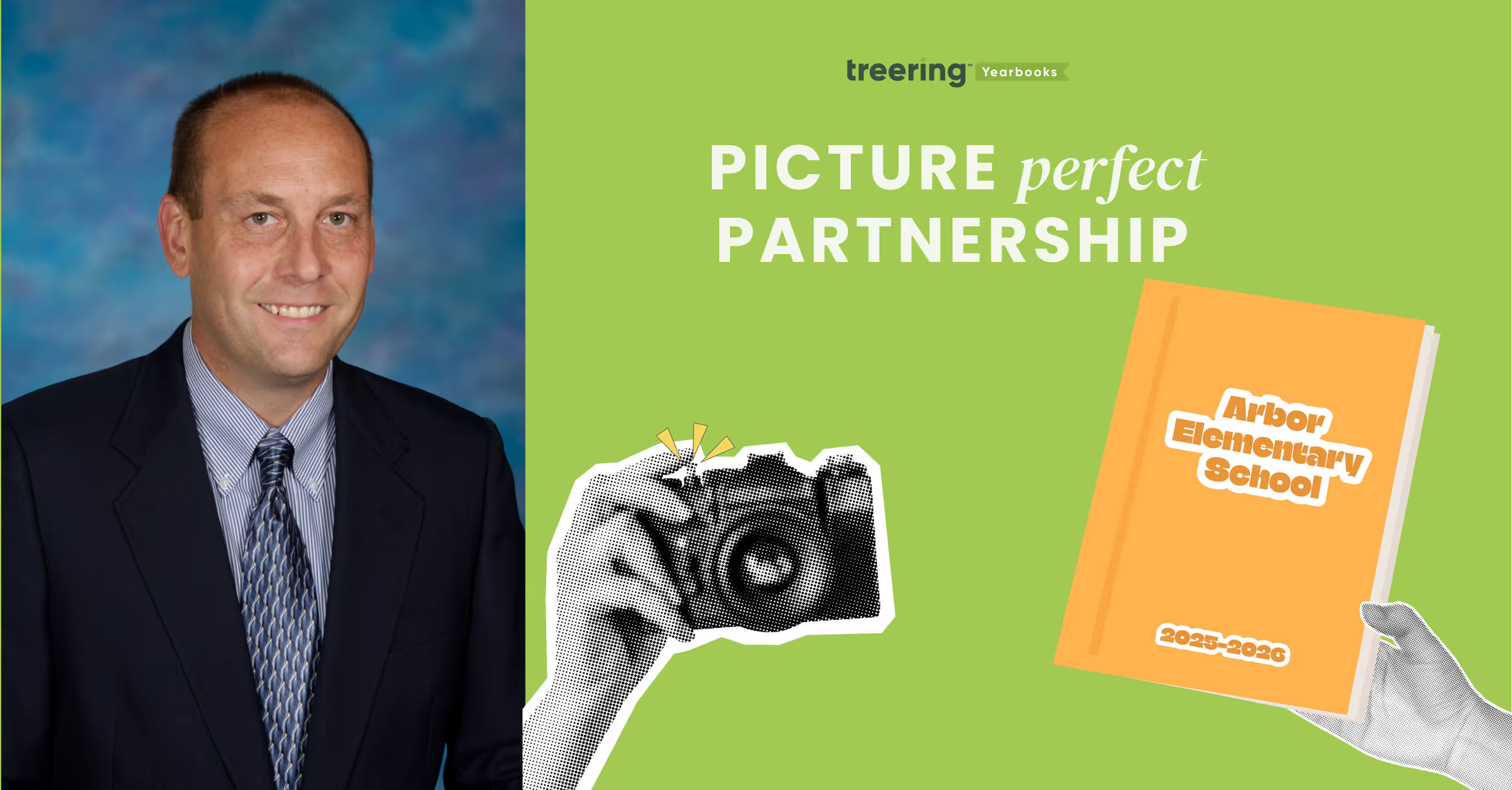
A pro photographer's playbook for perfect team shots
Our guest expert is David Burns, President of Color Portraits - a longtime Treering school photography partner servicing Illinois and Wisconsin. He's been framing perfect team shots since back when "post-game snacks" meant a chocolate bar with nougat and parents weren't yet reading ingredient labels.
After 20+ years and thousands of school photo sessions across the Midwest, I've seen it all—from squinting soccer teams in harsh sunlight to last-minute makeup photo scrambles for absent students. At Color Portraits, we've mastered the art and science of school photography, turning potential chaos into seamless operations that produce stunning results. These battle-tested strategies will transform your yearbook from good to unforgettable—without the headaches, delays, or disappointed parents.
Efficient Scheduling Strategies
For group photo days, we recommend scheduling one group every five minutes. This allows photographers to:
- Set up each group while the next one arrives
- Arrange students in height order for quick positioning
- Maintain a smooth flow throughout the day
For larger groups (school plays, entire grade levels), allow 10 minutes to prevent scheduling backups.
Middle School/Junior High Considerations
Middle schools typically schedule sports pictures three times yearly (fall, winter, spring). We recommend:
- Scheduling after school to accommodate parent-volunteer coaches and uniform changes
- Taking pictures during each sport's season for proper uniform distribution
- Capturing individual photos as athletes arrive in uniform, followed by group shots when coaches arrive
Composition Tips for Various Group Sizes
Create rectangular rather than square compositions to properly fill the frame. For optimal results:
- Utilize stairs, risers, or bleachers to ensure every face is visible
- Incorporate props for club photos to add character and personalization
- Consider photographing sports teams in their natural environment (soccer teams by goals, track teams on the track)
Lighting Techniques: Indoor vs. Outdoor
Indoor Photography:
- Provides consistent controlled lighting
- Allows for fixed flash distance and stable exposure settings
Outdoor Photography:
- Cloudy days offer less light variation but muted skies
- Sunny days provide vibrant backgrounds but create shadows and squinting
- Position groups with the sun behind them and use flash to reduce shadows
- Avoid direct sunlight into the lens
Student Identification Strategies
Send digital images to coaches or club sponsors for proper student identification. Maintain basic row formations to facilitate easy identification.
Balancing Posed and Action Photography
Our standard sports shoots focus on group and individual photos outside of game days. For action shots:
- Collect images from parents or yearbook staff taken during actual games
- Create collage pages featuring action shots from different grade levels
- Position these collages before or after formal group photos
Handling Makeup Sessions
When students miss the original photo day:
- Leave space in the original formation to add missing students via Photoshop
- This approach looks more natural than retaking group photos
- Retakes often create new absences, compounding the problem
File Organization Recommendations
Create an intuitive organization system:
- Establish separate folders for each team and club
- Request proper labeling (team grade level or club name) when parents submit photos
- Always back up all images to cloud storage or external devices
Accommodating Photo Restrictions
For students with privacy concerns:
- Ask parents if listing the child as "Not Pictured" is acceptable
- Omit names completely when parents request
- Prioritize parental decisions regarding their child's privacy
Timeline Planning for Yearbook Deadlines
Plan your photography schedule strategically:
- Capture club photos early in the school year when groups form
- Take sports team photos during their respective seasons when uniforms are available
- Complete all team photography by February at the latest
- This timeline provides yearbook editors ample preparation time
This comprehensive approach ensures your school's sports and club photography will be efficient, professional, and ready for yearbook publication.
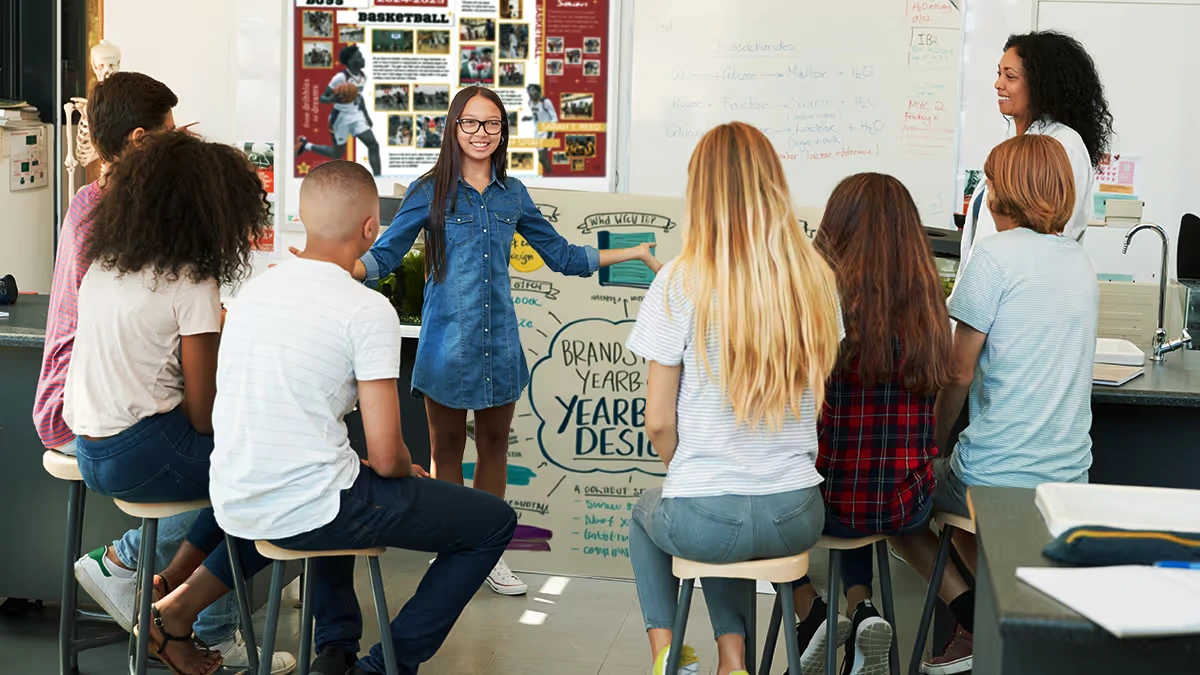
The 5 game-changing blog posts you’ve (somehow) been missing
You might be missing these favorite yearbook ideas. If any part of your yearbook process feels stuck, scattered, or stale, one of these posts is probably the solution you didn’t know you needed. Read them. Share them. Build them into your curriculum or club routine and watch your yearbook program transform.
1. Easy +1: a guide to leveling up your yearbook
This comprehensive guide outlines five key ways to elevate your yearbook beyond collage pages. It provides practical steps to add something new to next year’s book: a focus on storytelling, expanded coverage, better photography, or modular design.
Use the five focus areas to create
- Rotating workshop stations early in the year to build foundational skills.
- A self-assessment rubric for your team.
- A “Level Up” day where each leader identifies one area to improve in their section.
2. How to choose a yearbook theme
This piece walks you through the theme process without relying on chaotic verbal brainstorms. (Some yearbook creators even find its anti-brainstorming angle a little divisive. And we liked it.) It provides teaching support to non-designers and new advisers with practical, flexible guidance.
It includes prompts, real-world examples, and tips for involving students at all grade levels.
3. 10 people to thank
Yearbook creation doesn’t happen in a vacuum. This gratitude-focused post highlights the unsung yearbook heroes, including the front office staff, IT teams, principals, coaches, and more. Yearbooks are a high-stress, deadline-driven project; injecting gratitude is a reminder that the yearbook extends beyond your class or club.
Make gratitude part of your yearbook culture:
- Include a recurring “Who Helped You This Week?” check-in during staff meetings.
- In the yearbook, you can include a “Behind the Book” thank-you spread.
4. Adviser advice: keep, change, stop
One of the few tools that seamlessly transferred from student teaching to the newsroom is “Keep, Change, Stop,” a structured reflection tool. It helps teams evaluate the yearbook process with three simple prompts: what to keep, what to change, and what to stop doing. (Clever name, eh?)
It’s an adaptable debrief for editors, staff, and advisers alike.
In this blog post, four yearbook advisers share their POV. Based on their real-life examples, we have a framework to drop what’s not working and preserve beneficial habits each school year.
Doing this exercise with middle and high school yearbook creators encourages student voice and leadership in shaping the next year’s book. “Keep, Change, Stop” promotes a healthy, intentional yearbook culture.
5. Yearbook debriefing: a summer reflection
This five-minute read outlines a strategic, low-stress way to reflect on the yearbook process over the summer. It offers questions and prompts to help advisers and returning staff capture what worked and what needs to shift before the next yearbook creation cycle begins.
This post helps you process what happened while it’s still fresh, and with a little distance.
To use it now, assign editors a summer reflection form based on the post’s questions and use their input to build your back-to-school agenda.
We all want our yearbooks to stand out, and sometimes the best yearbook ideas (wink, wink) are hiding in plain sight. We hope these five blog posts deliver the clarity, creativity, and strategy you and your staff need.

Can our school afford to start a yearbook program?
Financially risk-free and school programming don't intersect often. When they do, pay attention. Traditionally a yearbook program begins with a deposit, requires minimum orders, and ends with an invoice. That's no fun! Certain schools cannot pay to play. Others can't afford to remain in the (yearbook) game. Would you believe there is another way? (Say yes, and keep reading.)
Does my School Need a Yearbook Program?
Teachers, administrators, and parent groups seek opportunities to enhance the student experience, foster community spirit, and leave a lasting impact. A yearbook program checks all those boxes at once. A yearbook isn’t just a book; it’s a time capsule. It captures the essence of each school year— friendships, achievements, trends, and more. Whether it’s the class photo or the quirky candid shots from the pep rally, the yearbook immortalizes memories that would otherwise fade away.
How to Get Started
Here’s a handy checklist to get your yearbook program off the ground:
- Gather your team: assemble a yearbook committee—teachers, parents, and students who share a passion for preserving memories.
- Find a publishing partner: the right fit here can make all. the. difference. Talk to company representatives, ask for a sample to see the quality, and be sure you understand what you can afford.
- Arrange training for your yearbook team.
- Spread the word: let everyone know about the exciting yearbook project. Generate buzz among students, parents, and staff. Treering has plenty of free marketing tools and ideas. (Even if you don't choose us!)
- Plan Ahead: set deadlines for photo submissions, design, and ordering. Keep everyone in the loop.
- Celebrate the Unveiling: host a yearbook reveal event. Popcorn, excitement, and memories galore!
The Treering Difference
Just thinking yearbook, may be overwhelming. It's one more proverbial ball to juggle. That’s why Treering focuses on making things as easy as possible for everyone involved: yearbook team members, front office staff, teachers, parents, and students.
No Deposits, Contracts, or Minimimus
Schools can afford Treering's financially transparent and risk-free approach because we don't saddle schools with yearbook debt, contracts, guaranteed minimums, or hidden costs. Phew. Removing those huge hurdles at the outset lets you focus on creating a high-quality yearbook highlighting the best moments and events.
Yes to Personalization and Support
Custom pages are a hit with students and families who have the option to include two free personalized pages that appear only in their copy.
Treering schools never pay extra for
- Training and support
- Moving deadlines
- Yearbook themes, clip art, and fonts
- Creating a custom yearbook cover
- Using portraits from any photographer
Additionally, the on-demand printing process means you’ll get lots more coverage of spring events and sports. Treering only prints what you order, so there are no overruns.
A Tradition Worth Starting
Starting a yearbook program establishes a special tradition within your school community. Imagine the excitement during the yearbook reveal, the buzz as students eagerly flip through its glossy pages and the pride of seeing their own faces alongside their peers.
Remember, a yearbook isn’t just a book; it’s a legacy. So, go ahead—start your school’s yearbook journey with Treering. Your families and students will cherish the memories and you’ll be able to showcase all the great things happening in your school community! You’ve got great stories to share and Treering can help.
Treering would like to thank Dara Arouh, a Georgia-based yearbook mom of two, for contributing this blog.

The write stuff
No one reads yearbook stories. Sound familiar? I felt that way in my first five years advising. Focusing on photojournalism was almost an act of rebellion against the genius who mentored me in my high school’s newsroom. Yes, pictures are worth a thousand words and all that. By adding writing to your yearbook pages, you give names to faces and intent to actions. It’s more than so-and-so on the thing doing the thing; it’s context and clarity. It's a change for the better.
Copy as design
I’ve said it for years because my aforementioned high school adviser brainwashed me (in a good way): Content drives design. If you plan on increasing your yearbook’s written content, learn how to design with copy.
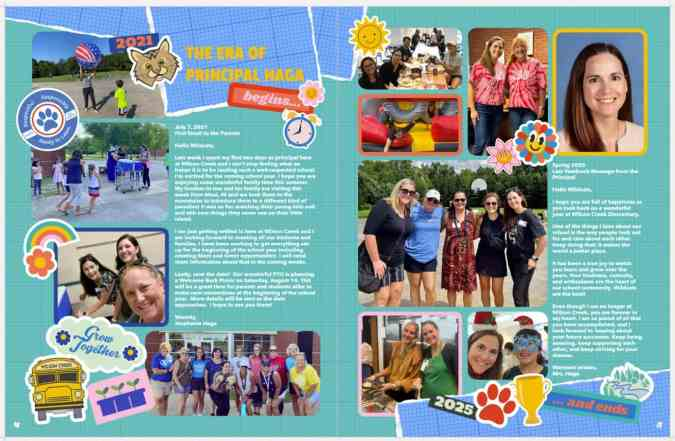
Headlines
Headlines are a great way to connect yearbook spreads back to the theme. On a spread about robotics, push yourself to make the main verbal entry point read more than “Robotics.” Your headline font, weight, color, and placement are just as important as the dominant photo.
Captions and stories
While not every topic may need a story, (nearly) every photo deserves a caption. Captions are entry-level writing opportunities. Compare the two spreads below. They are from the same yearbook. One is captions only; the other has a story.
The captions are close to the photos they complement. The story connects to the headline and subheadline.
How to introduce writing to the yearbook
As an adult, it can be tough to approach another adult and have a conversation (cool mom at the playground, I’m looking at you). Likewise, getting students to approach their peers isn’t the easiest skill to teach. As with all skills, take the easy +1 approach: start small, master that skill, and add another.
A progression, like the one below, builds confidence while building familiarity.
1. Introduce a question of the day (QOTD)
The heading says it all. Advisers or the editorial board select a question, and yearbook students ask four non-yearbook students the QOTD.
Yearbook creators are encouraged to start with their peer groups and branch out. The only caveat is that they cannot ask a student a QOTD twice until everyone has had a chance. No repeats. You can track this with a BOLO (Be on the Lookout) board, via a Google Sheet fed by a Google Form, or with your roster.
Do the math with me for a second: if six yearbook students each interviewed four students daily, that would be 120 student voices added to your yearbook in a week. With a larger staff of 18, that’s 360 new voices. Use these as Q&A moments in your portrait section or sidebars through athletics, arts, and student life spreads.
With those figures, you could get a meaningful quote from nearly everyone on campus each quarter.
2. Practice interviewing in class weekly
Repetition builds skills, and we educators know that. In the yearbook classroom or club space, the work of photoshoots, layout design, and marketing sometimes overshadows the process of creating. Take time to teach, practice, and evaluate your team’s skills. Here are a few ideas:
3. Take it to the street!
The key to a good yearbook interview is to have good questions. While there are hundreds of lists on the interwebs (we list some of our favs below), tailoring the interview to the subject will always give you the best material.
The best way to prep is to craft questions using the Five Common Topics: definition, comparison, relationship, circumstance, and testimony.
Once you have a list of questions—“Give me a quote for the yearbook” does not count—ask them!
The late Casey Nicols inspired a love of focus groups in me. As a journalism mentor, he encouraged me to bring in clubs or teams at lunchtime and interview the group. There was strength in numbers for them, as interviews were new for our yearbook staff. And our staff received some of the best quotes because they would play off each other.
As a result, their writing became interesting. Students read it. It became the expectation.
4. Start small
Remember, easy +1. If there is no writing in your yearbook, add captions. Play with sentence structure so it’s not always subject-verb-adverb. Add a prepositional opener. Make it a complex sentence. Then
You don’t have to do it all. Ever. Tell your community’s story your way.
Help with interview questions
Use these lists of interview questions for creating QOTD, practice interviews, and as launch pads for longer form copy.
You can even have students rank their favorite and least favorite questions. Make sure they have a reason why. Re-write the “bad” questions and craft follow-ups for the helpful ones.

2025 custom page design contest winners
You, too, believe every child deserves the spotlight. And when you took on the open-ended challenge to celebrate in style, your creativity, honesty, and heart were on full display.
We're honored to showcase the showstopping designs and the stories of the creators who brought them to life.
Grand Prize Winner
Narrowing down over 1021 entries to the top 100 took two days. We reviewed every submission carefully, appreciating the heart behind each one. Designs that went beyond the template rose to the top because they had personal touches.
In each round of evaluations and re-sorting, one spread stood out and eventually became the $500 Grand Prize Winner.
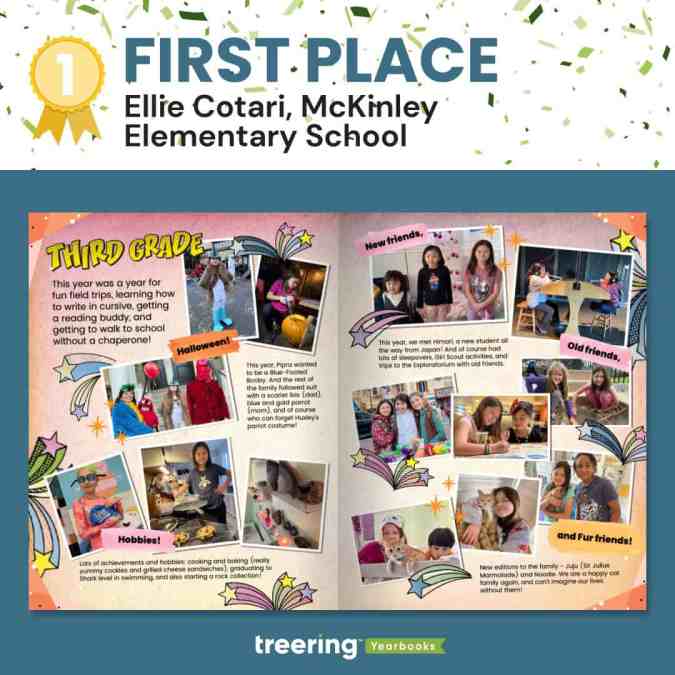
Why we loved it: It showed how design can be energetic and balanced. Both the warm colors and shooting stars are lively.
"It screams, 'third grade,'" a judge said.
And yet, with all that is going on, the main entry point is still the headline, and your eyes move in a circular pattern. There are verbal guides to highlight the five main sections. Cotari keeps it grounded by using a consistent photo style and typeface.
Cotari said, "It matches [my daughter's] personal style, hobbies and interests, and her playful personality!"
POV: People Sent their Favorite Moments and Somehow they're OURS Too!
Nearly all the submissions captured a different perspective: students shone across academics, athletics, and activities. Grandparents held places of honor and remembrance. Together, we gushed over pet pics and cried over stories of overcoming trials. Check out the top 100 submissions before seeing the Big Ten.

Thank you for embracing the spirit of Treering's custom pages and giving your child the spotlight.
Custom Page Design Contest Finalists aka the Big Ten
A group of judges combed through the top 100 to create the top 25, then top 15, and finally, the top ten. Each of the runners up earned a $50 Amazon gift card for their visual interest and originality.
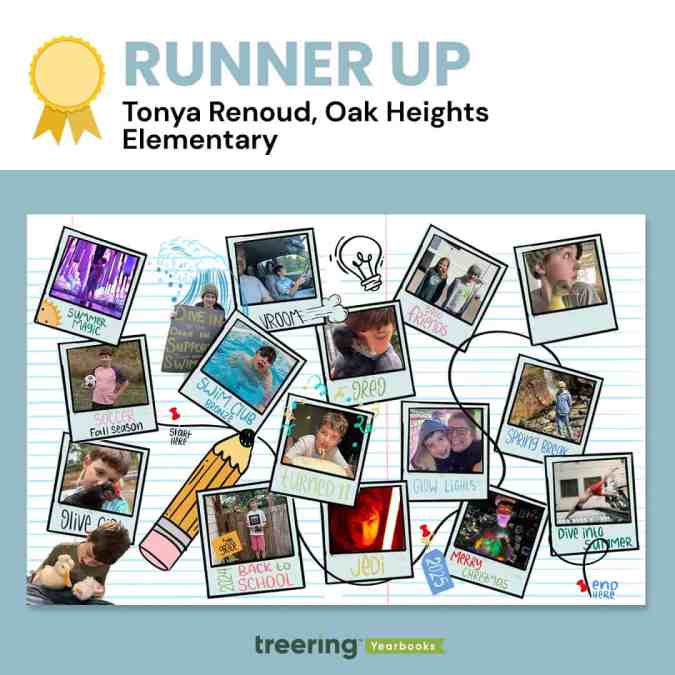
Tonya Renoud, Sweet Home, OR
Why we loved it: Renoud had us at start here.
"When he looks through these years later, he can walk down memory lane," she said.
This is exactly what she gave us. There is a path peppered with highlights from the end of summer to the start of next summer. Pets—this might be our first-ever duck submission—are especially timestamps in childhood.
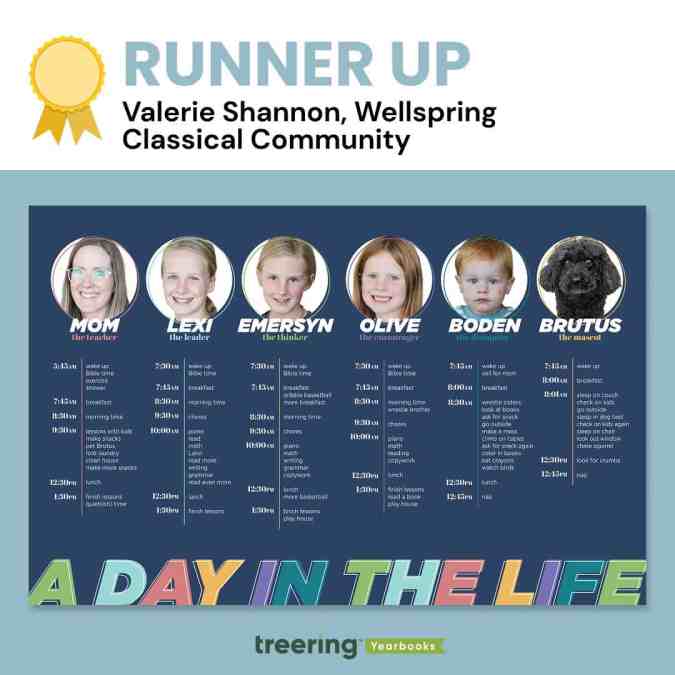
Valerie Shannon, Findley, OH
Why we loved it: Brutus and Boden.
At a glance, these two family members stand out because of their cute factor. Once we stopped to read, Shannon won us over with her tongue-in-cheek copy, which she called a "fun peek into our homeschool day."
"The theme of this year's contest was 'Every Child Deserves the Spotlight,'" a judge said, "and she managed to use her spread to give four kids, the dog, and herself a moment to shine."
Shannon's design is clean despite being full of copy. We love how she chose a color palette and anchored each family member's daily routine with one color using a tool line and circular frame. Both the frame and the knockout on the heading text are offset. It's these little details that elevate the design.
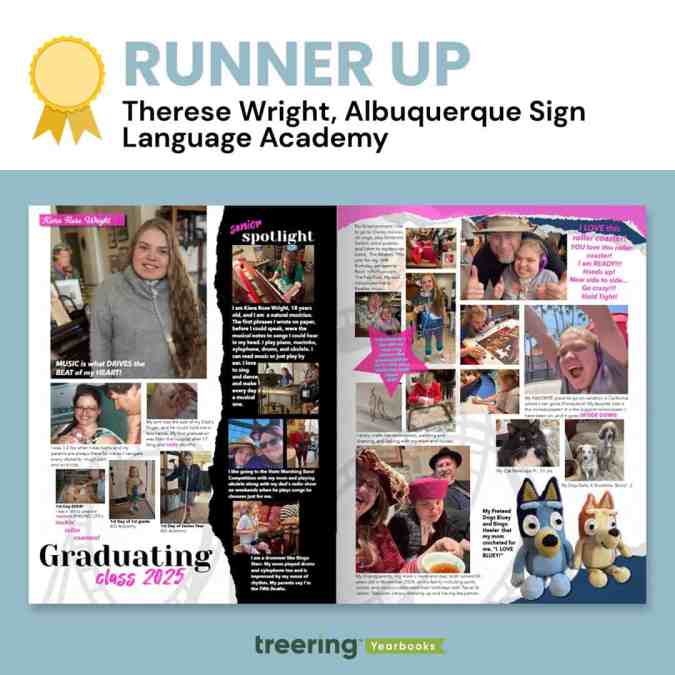
Therese Wright, Albuquerque, NM
Why we loved it: This was one of two magazine-style custom pages that captivated us. We loved the torn elements and how Wright used the black paper to highlight moments from her daughter's senior year. For Wright, these design elements held further meaning:
"Torn pages with rough edges, curving tracks, splashes of pink (representing moments of easier breathing) brighten up the darker moments that have strung these ups and downs together and keep her rock 'n rollin toward an unknown future, able to face each new challenge and sing, 'I am ready! Hold Tight!'" Wright said.
The watermarked roller coaster further illustrates the Wright Family's journey, which began with a 17-month ICU stay. Despite countless hospitalizations, communication barriers, and daily health challenges, Wright's daughter has persevered with strength and joy, communicating through American Sign Language and music.
This is the ultimate senior celebration.
"Albuquerque Sign Language Academy gave her a voice in the world and a place to belong from 1st grade to 12th," Wright said.
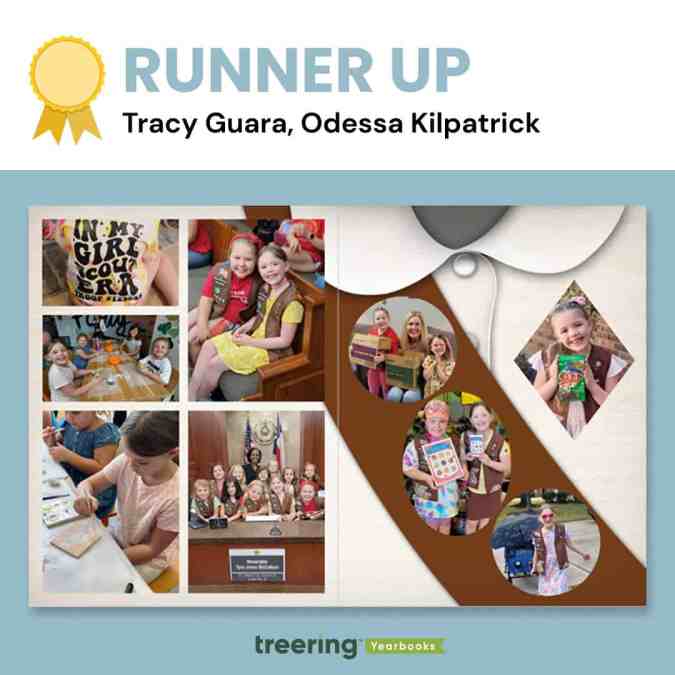
Tracy Guara, Katy, TX
Why we loved it: The photos as badges caught the judges' eyes, as many identified with this milestone as troop leaders or former Brownies.
"This is a moment in time," said a judge. "It's exactly what custom pages should be."
Guara's daughter is a fourth-generation Girl Scout who achieved badge and cookie-selling goals.
"I was honored to create this spread mimicking a Girl Scout Brownie sash," Guara said.
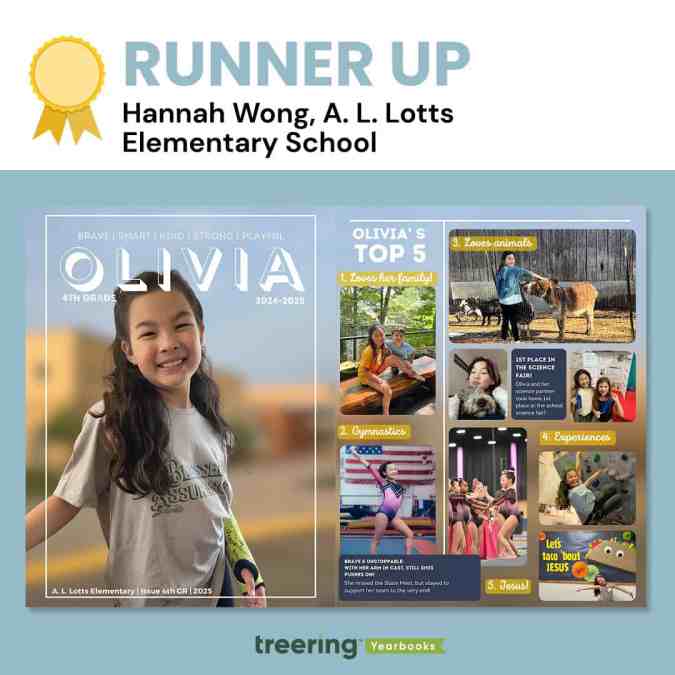
Hannah Wong, Knoxville, TN
Why we loved it: It looks complicated.
"This spread is not just a collection of photos and milestones," Wong said, "it's a heartfelt tribute to her dedication, growth, and the pride I feel as her parent."
The layers made it rich. With a single photo as background across the spread, Wong layered photos, editable shapes, and textboxes to create this magazine-inspired look. Even with all the content, she maintained alignment in her columns (the designers really geeked out over this) and pulled color from the background to connect the top five headlines.
While it looks complicated, the layout is clean and straightforward to recreate with Treering tools.

Dana Denning, Albuquerque, NM
Why we loved it: Everything points us into the spread.
Denning's choice and use of graphics here are masterful: the plane is flying toward the center, the arrow points to the center, and even the shadows on the skyline at the base of the spread lead toward the center. Additionally, her spread uses a design hierarchy we don't see outside of traditional yearbook pages.
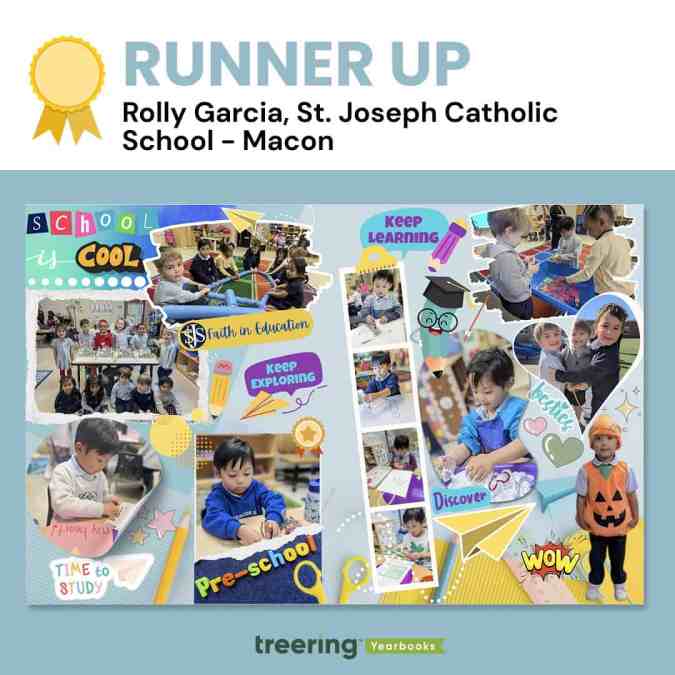
Rolly Garcia, Macon, GA
Why we loved it: It's cliche, but this spread truly put the cool in school. With playful colors, encouraging graphics, and photos of highlights in- and outside the classroom, Garcia captured the spirit of early childhood education.
"The filmstrip has those fine motor milestones in the classroom," said an educator-slash-judge. "We see pencil grip and dexterity skills developing."
Garcia said, "A notable element in the design is the paper airplane, which symbolizes the concept of 'soaring'—reflecting the idea that when students learn and grow, they are empowered to reach new heights."
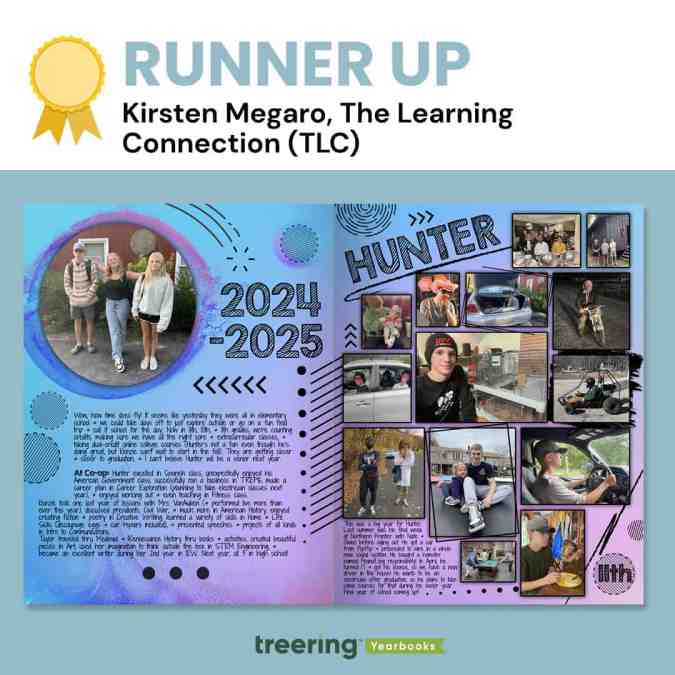
Kirsten Megaro, Great Meadows, NJ
Why we loved it: Megaro's extra touches of texture made us want second, third, and thirtieth looks.
"I know this was made in the Treering app," said a judge, "but I can't help but think it was first a pen-and-ink creation in a notebook during math class."
The judges loved the rectangle at an angle, the use of circles, and the font choices. They also emphasized the black scribbles and frames, which brought clarity to what could have been a complicated visual.
"We want to celebrate and remember the 'regular' moments of life," Megaro said, "not just the school-related stuff, so these pages allow us to do that and we love being able to look back on them from year to year."
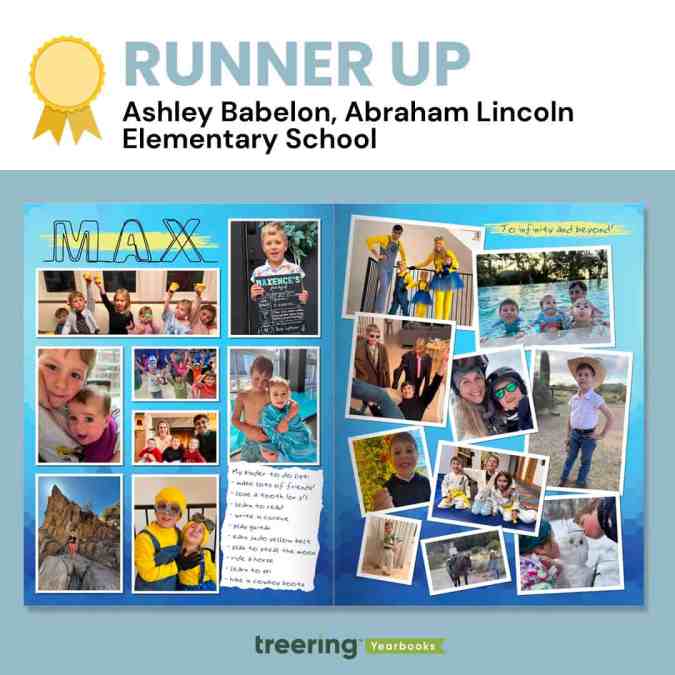
Ashley Babelon, Chicago, IL
Why we loved it: Max's kinder to-do list became an "eye spy" moment for us. We wanted to see if he ticked all the boxes. (He did!)
"Max also loves 'Toy Story' and Minions, and so the color scheme and font act as a mini time capsule of the things our little boy loves right now," Babelon said.

Ileana King, Stevenson Ranch, CA
Why we loved it: From the interview to the before-during-after photos, we loved the depth of coverage on this spread.
King said, "To add a fun twist, I used AI to create the sticker of a capybara and a T-rex, two of his favorite animals, riding a roller coaster. Then I added Treering graphics to make it look like Space Mountain, which is my son's favorite roller coaster."
One of the judges said, "This is one of the things you pull out when a future daughter-in-law comes over."
Thanks to all who entered and shared their story with us.

Treering coupons: get a great deal on your school yearbook
Here at Treering, we keep school yearbook prices simple. Your yearbook pricing has two factors: page count and cover type. With this all-inclusive approach, there are no minimum orders, shipping costs, contracts, or hidden fees to consider, and your team will have access to everything they need (templates, design tools, support, and more). This way, you don't need to go searching all around the internet for "Treering Coupons."
But if you did that—and ended up here—we'll give you the inside scoop on how we approach discounts, so you know when and how you can save money.
Treering Coupons for Parents and Students
Treering discounts school yearbook prices in the fall. This early purchase discount is a marketing tool for advisers to gain momentum for book sales and it helps parents lock in a great price. We think it’s a win-win-win.
Here’s how the discount schedule works:
- August: 10% off
- September: 10% off
- October: 10% off
Because these discounts are automatically built in, parents and students don’t even need Treering coupons to take advantage of the deal. They’ll automatically get the sale price when they pre-pay.
Treering Coupons for Yearbook Advisers
When yearbook advisers work with Treering, they can score their friends a great deal on their school’s yearbook prices while also earning free books for their school.
Here’s how it works:
- Yearbook advisers using Treering share their special referral coupon code with friends and fellow yearbook advisers.
- When yearbook advisers sign up their schools with Treering for the first time, they can use that special coupon code to receive 10% off their school’s yearbook prices.
- The yearbook advisers who shared the code earn up to 10 free yearbooks for their school each time those new schools sell their first yearbook through Treering.
Not Using Treering For Your School Yearbook?
Treering has helped more than 20,000 yearbook advisers do really cool things with their yearbooks without their efforts feeling like a full-time job. We’ll show you how we can do the same for your community.

The benefits of joining yearbook committee for students
Yearbook committee is a great activity for students to get involved with, but not all students know the benefits that it can bring them. Plan ahead for next year by planting the seeds in students'heads now about why they should seriously consider joining in on the yearbook fun next year.
Drive home to them that some of the benefits of joining the school’s yearbook committee include:
Getting involved
Not every student is into sports or possesses musical talent. But that doesn’t mean that they can’t get involved with their school. Joining the yearbook committeegets students involvedon all levels – from mingling with students, to attending school events, and actively participating in something that benefits the entire school body. Students benefit from yearbooks just as much as the schools do in creating a positive school spirit. And when kids have school spirit, they perform better as students.
Teaches crucial life skills
Deadlines, deadlines, deadlines. A yearbook staff is never short on deadlines. But even though they sound stressful, deadlines can be very beneficial in helping students learn skills that they will use through school, college, and the rest of their lives. Time management, prioritizing, reliability, and the responsibility of following through on tasks when others are depending on you are just the tip of the iceberg of skills that students learn when working on a yearbook.
Provides writing and journalism experience
Writing copy for yearbooks is a lot harder than it might originally appear. When students are forced to use rules of proper attribution, go through an in-depth interviewing process including follow ups, or are crafting a creative piece, they build upon the fundamentals that they learned in English class. Practice makes perfect and the more you write, the better you get at it.
Provides creative experiences
Photography, Photoshopping, page layouts, yearbook themes, design ideas – putting together a yearbook from start to finish is full of tasks that get the creative juices flowing. It’s very rewarding for students to have the physical proof to show for all of that hard work they put in over the course of the year. When anyone first starts a project, it’s easy to get lost in all of the details. But being able to look back at the end and see your creation is a great feeling that gives students a strong sense of pride.
Great addition to a portfolio
Whether they are trying to get into AP English classes in high school or they’re sending out applications for college, being able to have yearbook committee included in your portfolio gives you that much needed edge. Schools can be a very competitive business and often good grades alone aren’t enough to get into the school that students are hoping for. When a student is able to show that they were an active member of a hard working team, it helps showcase their overall skills in multitasking, socializing, developing ideas from concept to execution, and everything in between. A well-rounded portfolio is very important in whichever direction students choose to move forward in their academic careers.
For students who are looking for a creative outlet, looking to learn the pressures of deadlines, or looking to learn the basics of reporting, your school's yearbook club or committee is the place for them to be. They might need to be recruited, but what they need to know most is how much joining a yearbook committee will benefit them.
Sell them on that, and your yearbook will be better because of it.

